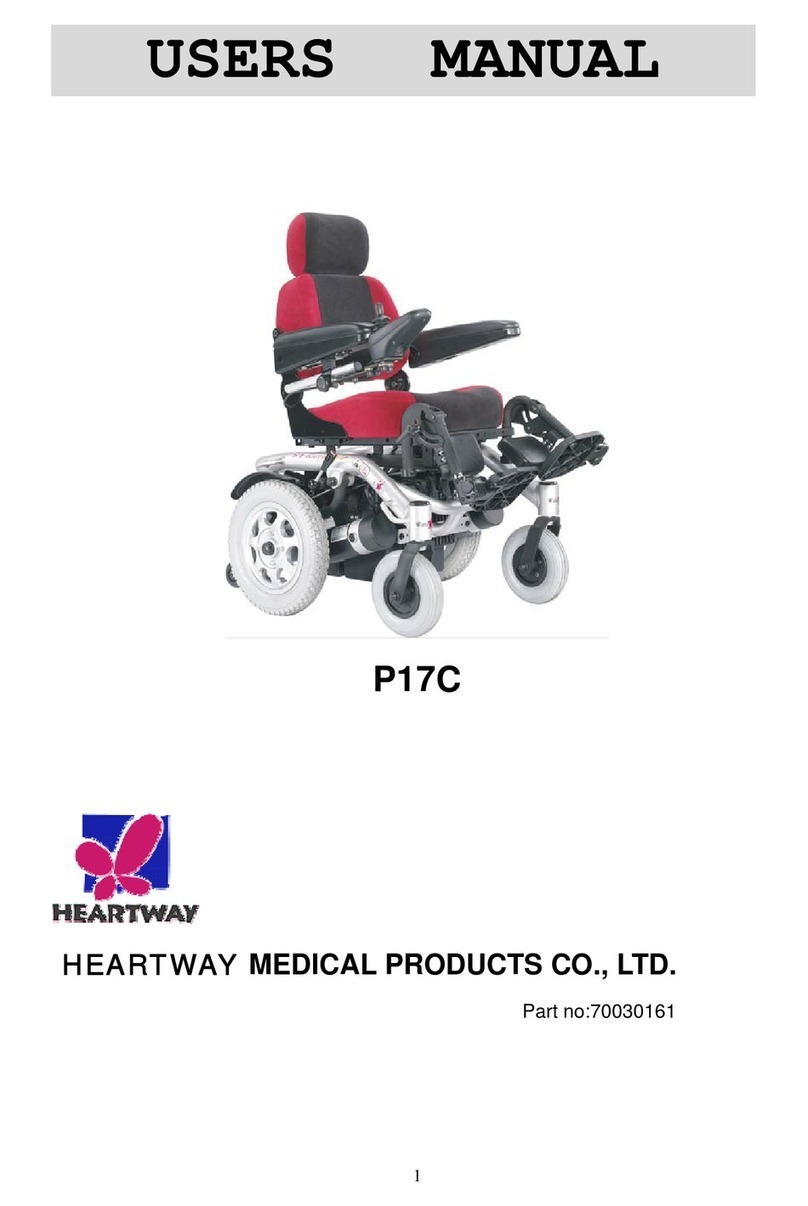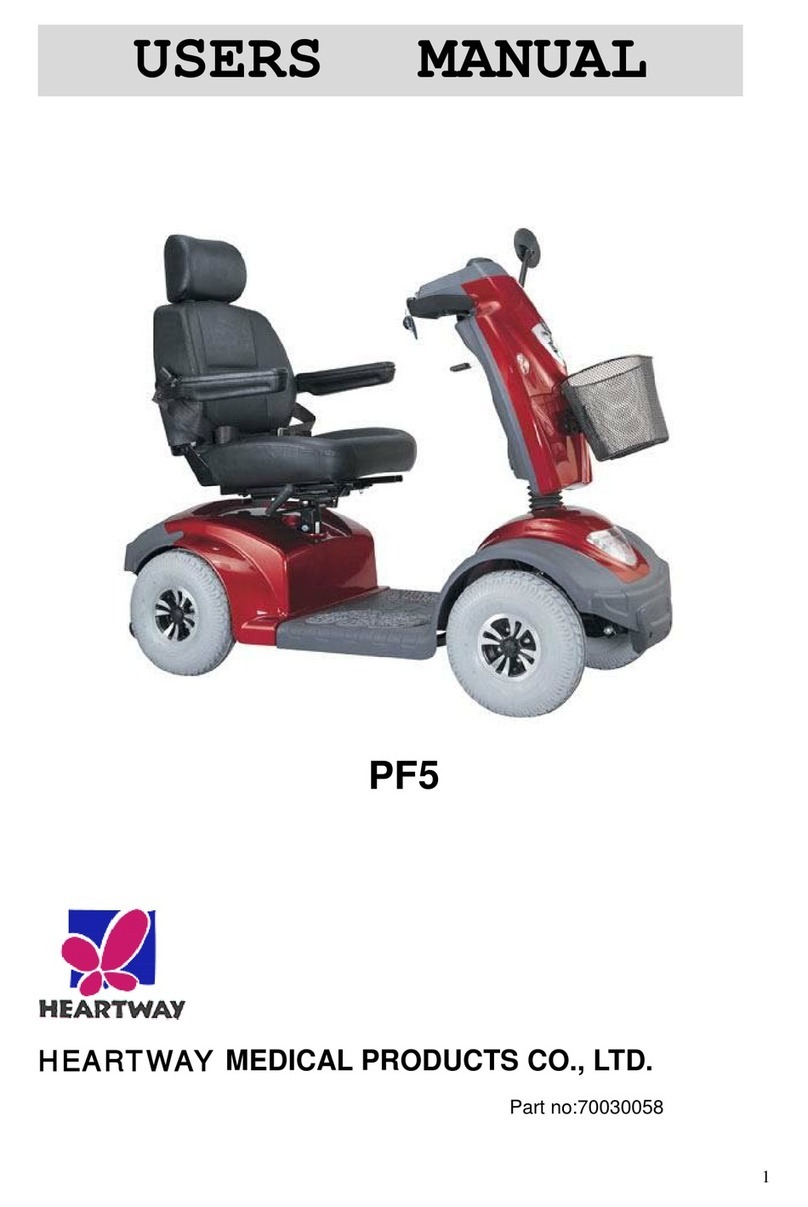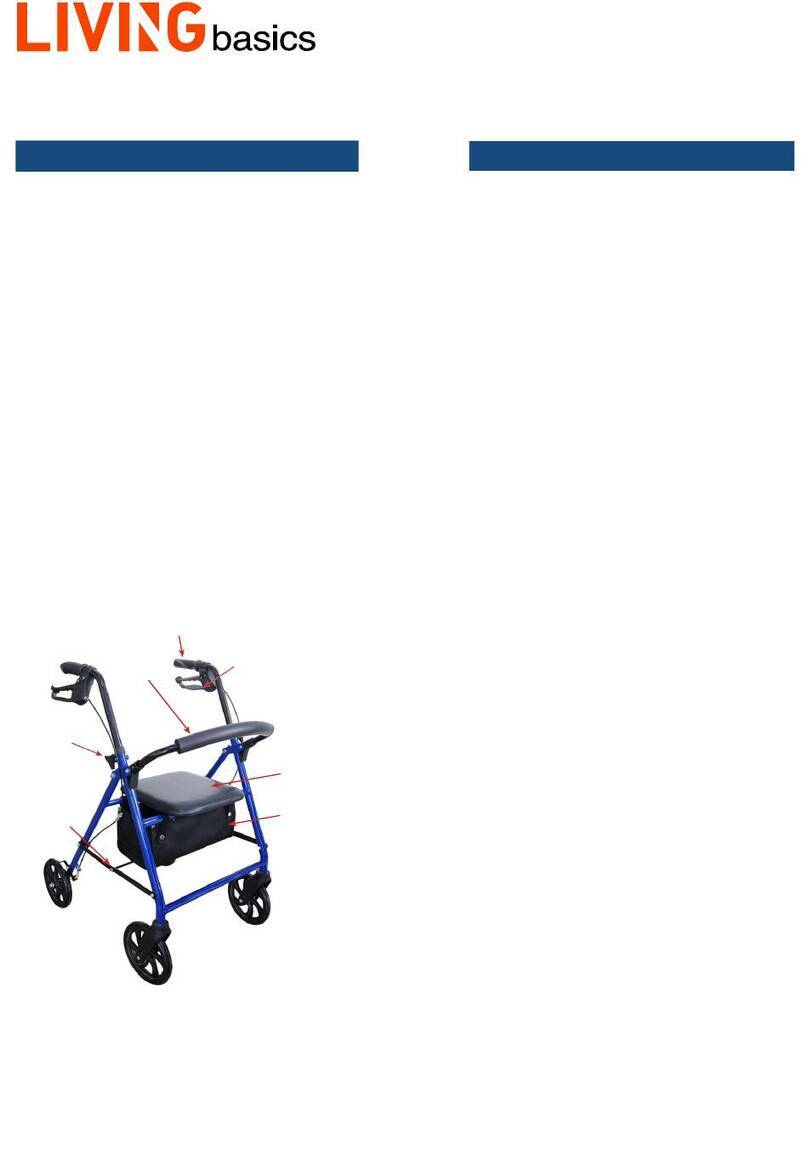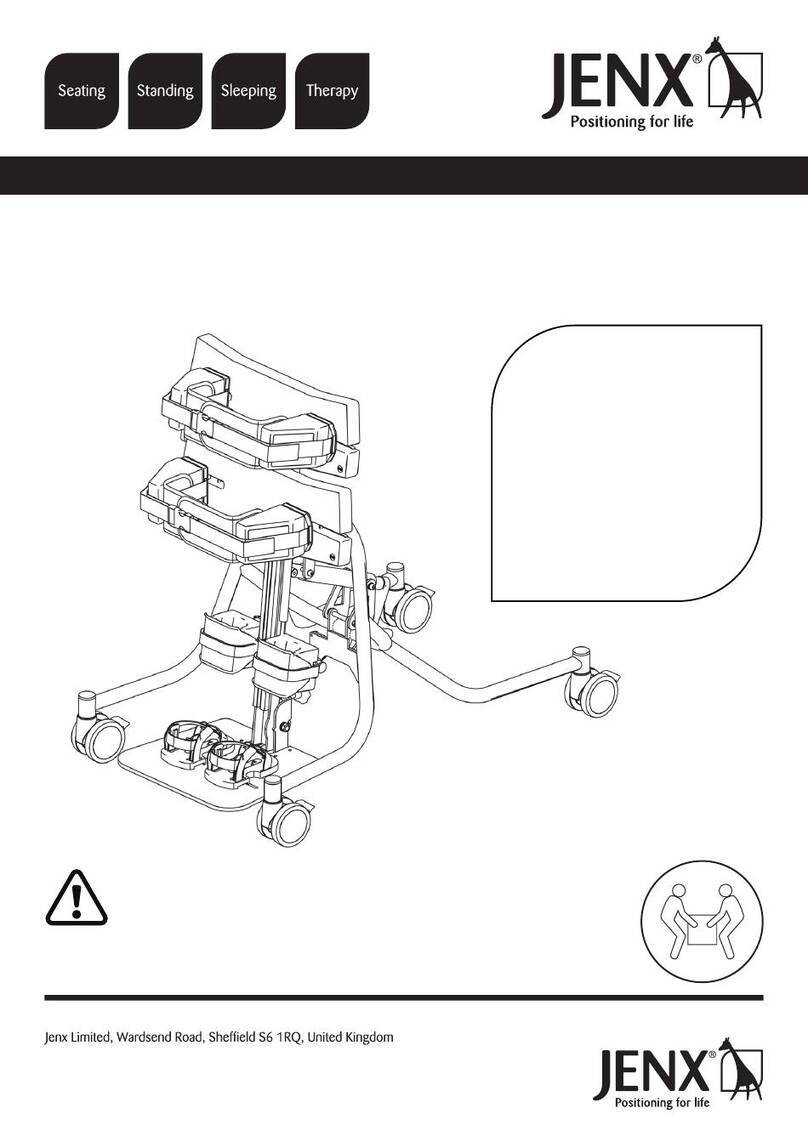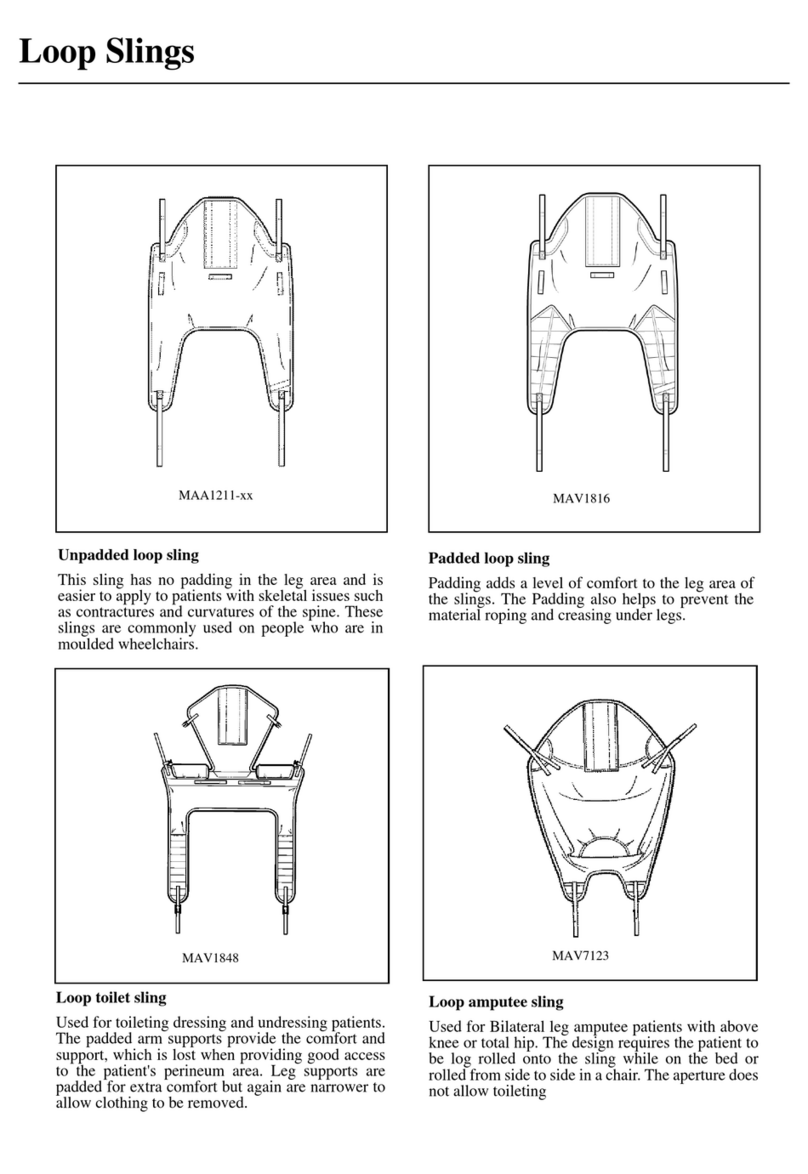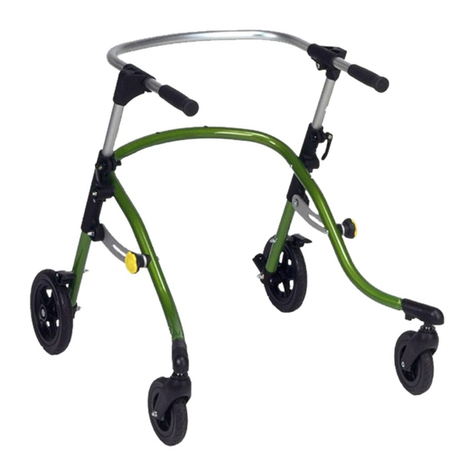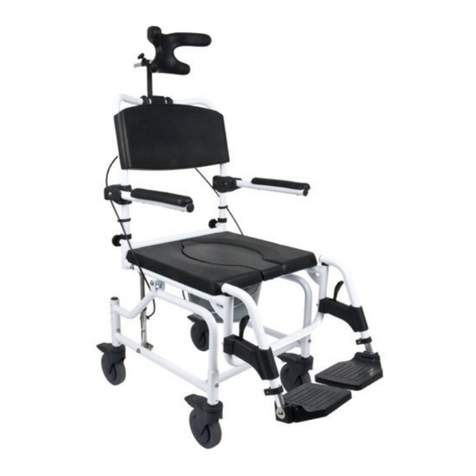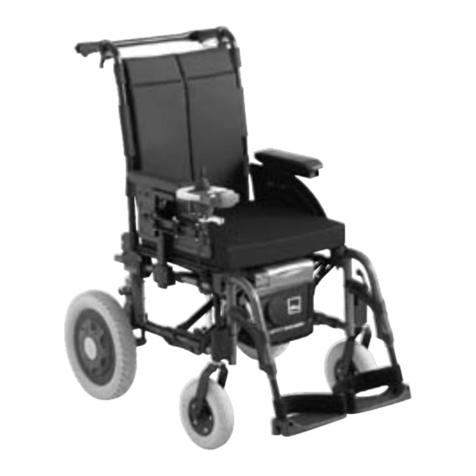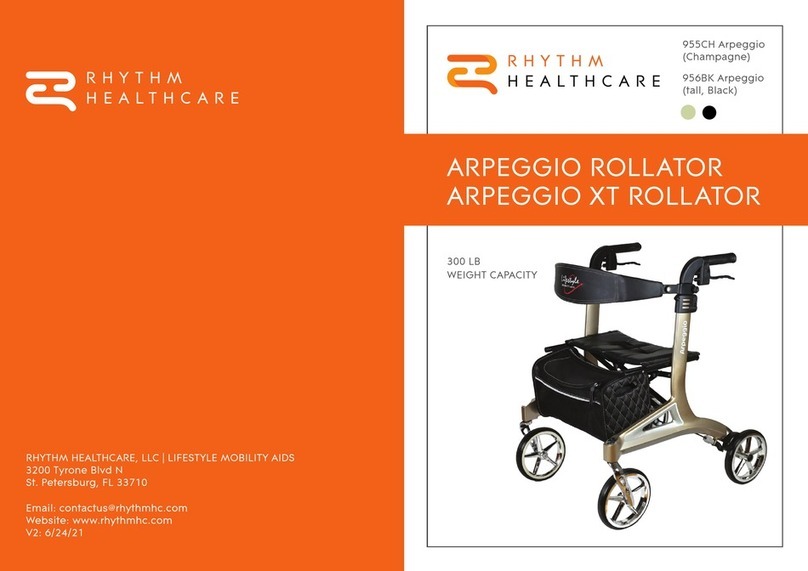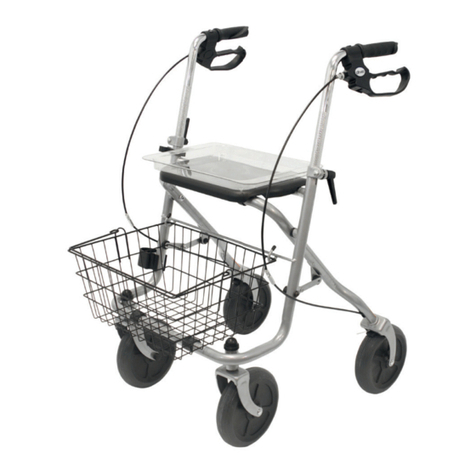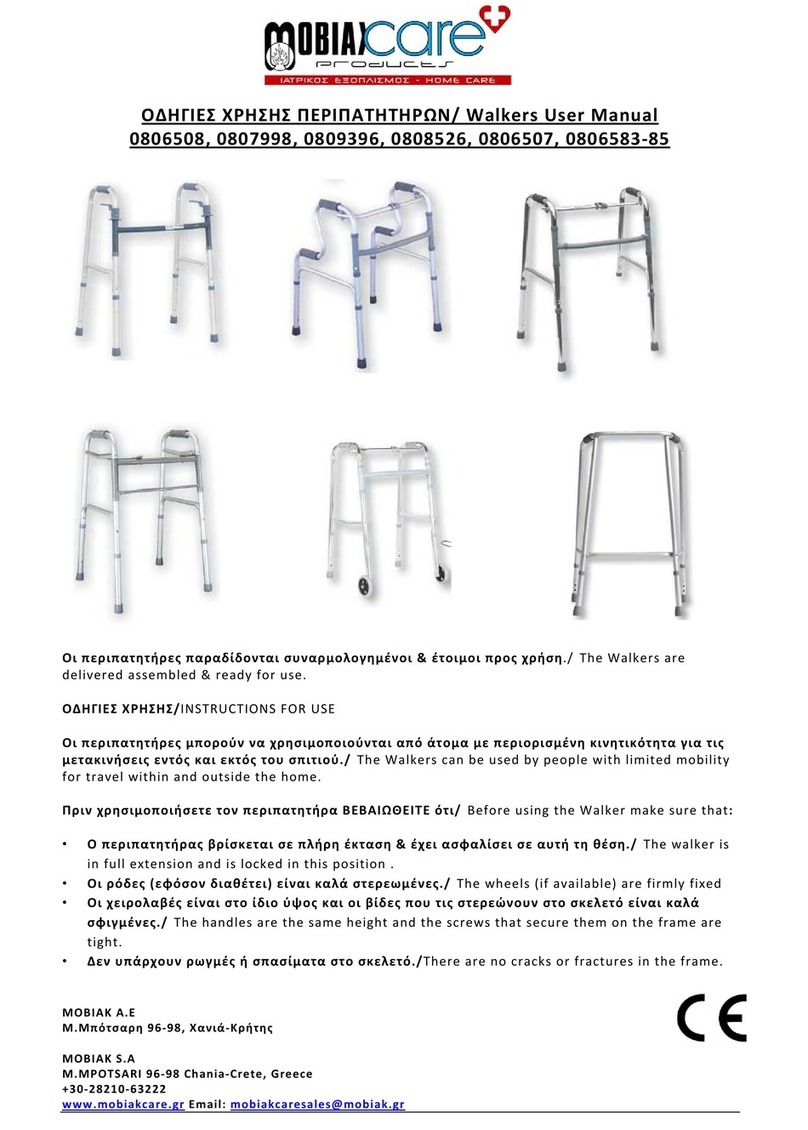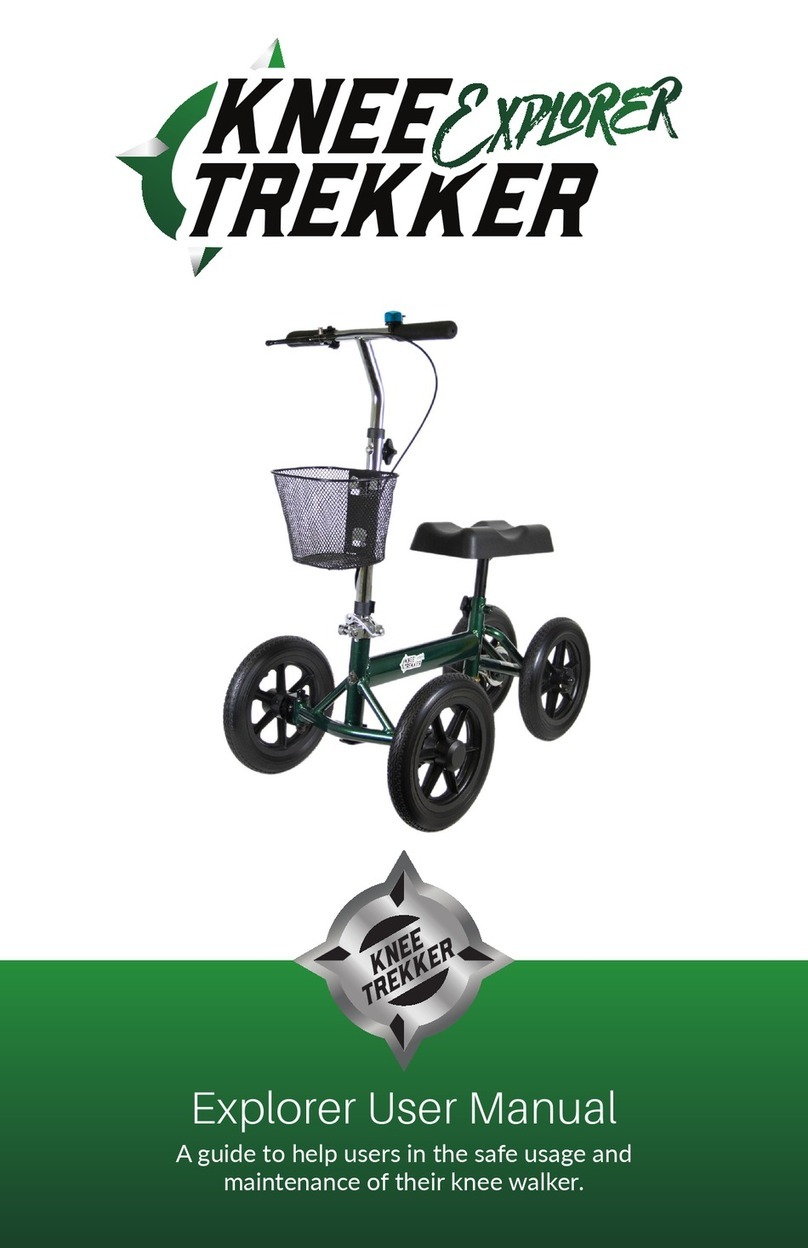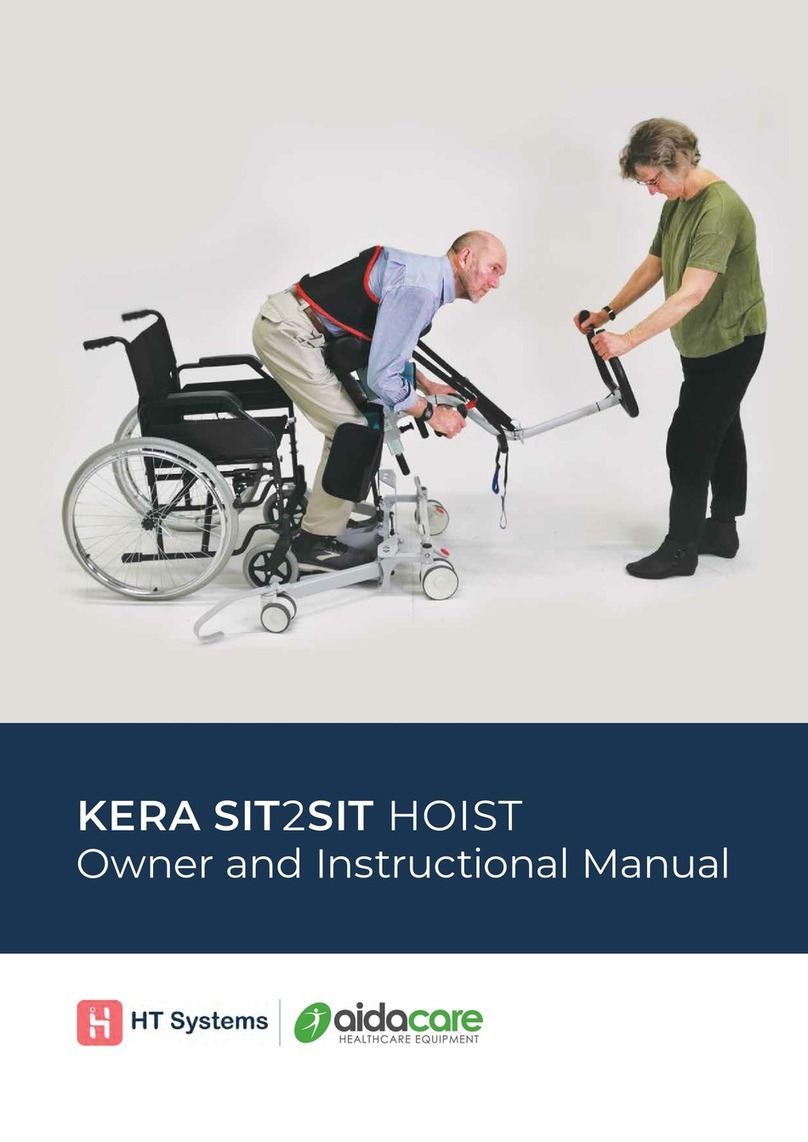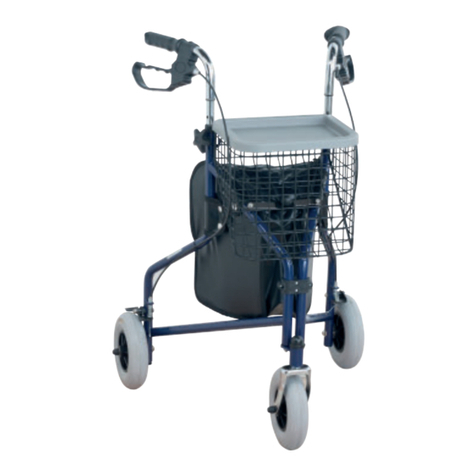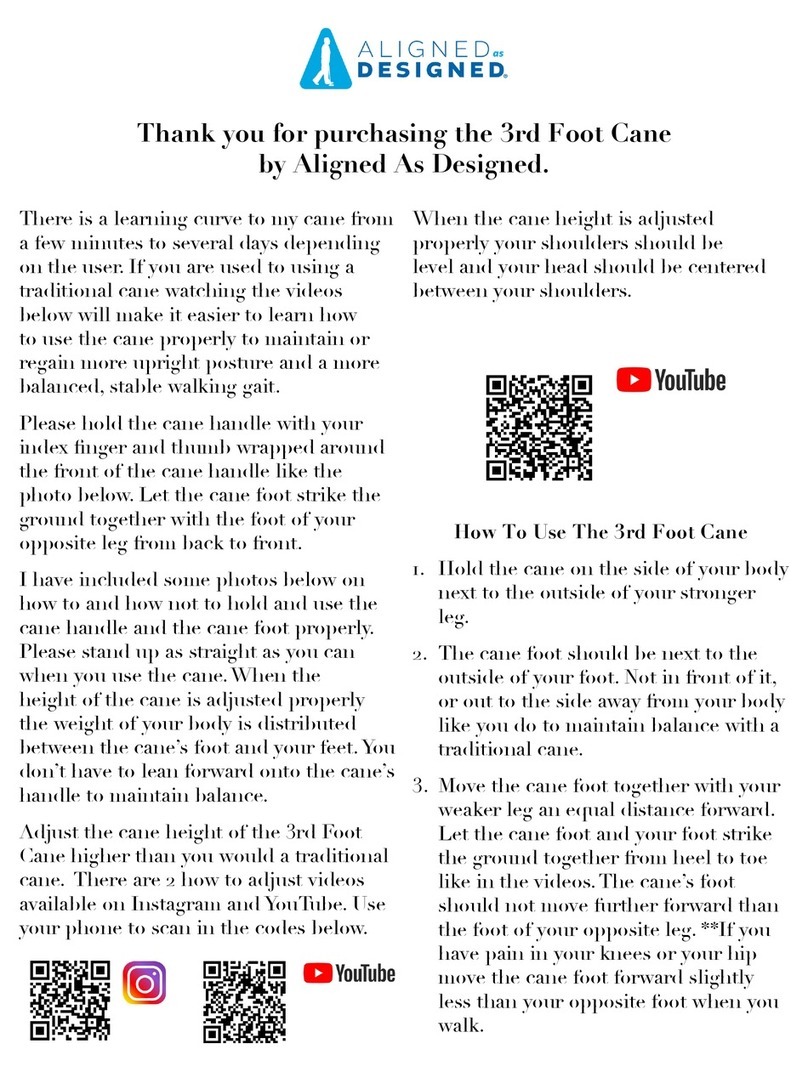Heartway Medical Products P23C User manual

1
.USERS MANUAL
P23C
HEARTWAY MEDICAL PRODUCTS CO., LTD.
NO. 6, ROAD 25, TAICHUNG INDUSTRIAL PARK,
TAICHUNG. TAIWAN R.O.C.408
PUBLISHED: Nov. 19, 2009
VERSION: 1 Part no: 70030186

2
COMPONENTS
Your power wheelchair is shipped partially dissembled to protect it during shipping. After
unpacking, please check whether you have received the following main components as our
standard specification (See Fig.1).
1. Main frame with motor 5. Armrest(left)
2. Headrest 6. Footrest
3. Seat /Backrest 7. Controller
4. Armrest(right)
(Fig 1)
2
3
4
5
6
7
1

3
SAFETY INSTRUCTION
Operation of Chair
1. Always ensure that the power is switched off when getting in or out of the power wheelchair. This will
eliminate the possibility of accidentally activating the
joystick and causing injury to yourself or others.
2. Always check that the drive wheels are engaged (drive mode) before driving.
3. Set the speed control knob according to your driving ability and the environment in which you are going
to operate. We recommend that you keep your speed at the slowest position (fully press the deceleration
button) until you are familiar with the driving characteristics of the vehicle. We also recommend that you
use the slowest speed when using your power wheelchair indoors.
4. Always reduce your speed when making sharp turns.
5. Do not switch off the power when the wheelchair is still moving forward. This will bring the chair to an
extremely abrupt stop.
6. Avoid jerky stop/start motions as it will result in excessive current draw from the batteries, increased tire
wear and the rapid wearing of the gearboxes and motors.
7. To brake in an emergency, simply release the joystick.
Ramps and Curbs
8. When driving up or down ramps, be sure to check that the angle of the slope is less than 10 degrees
(slopes about 1/6). Also check that ramp surface is roughened to prevent slipping. Never drive across a
slope or turn sharply on a slope.
9. When driving up curbs, always check the height of the curb to ensure that it does not exceed
1-1/2”(40mm) height.
Transfers, Reaching and Bending
10. Transferring on and off the HP6 requires a good sense of balance. To eliminate the possibility of injury,
we recommend performing the following tasks before attempting a transfer:
→ Position chair so that the distance between your power chair and the object to which you are
transferring is close enough for a safe transfer.
→ Turn the power off
→ Ensure that your power chair not in freewheel mode.
→ Flip up or remove armrests
→ Flip up footplate or remove footrests
→ Turn both caster wheels towards the transfer direction to improve power chair stability during
transfer.
11. When reaching, bending or leaning while seated on your power chair, make sure that you maintain a
stable center of gravity to keep the power chair from tipping.
General
12. Always use a seat belt, and keep feet on the footplate at all times.
13. For safety reason, make sure that your weight does not exceed the recommended weight limit of the

4
wheelchair. Consult your dealer for the specified weight limits for your particular model.
14. Do not attempt to lift or move a power chair by any of its removable parts. Personal injury and damage
to the power chair may result.
15. Do not stand on the footplate directly.
16. Never try to use your wheelchair beyond its limitations as described in this manual.
17. Do not operate your vehicle if it is not functioning properly.
18. Do not connect any electrical or mechanical device to the vehicle. Failure to obey this instruction may
result in injury and will void the warranty.
19. Never use electronic radio transmitters such as CB, walkie-talkies, portable computers or cellular phones
while using the vehicle without first turning the vehicle off.
Use While Under The Influence Of Medication OrAlcohol
20. Check with your physician if you are taking any medication that may affect your ability to operate your
power wheelchair safely.
21. Do not operate your vehicle while you are under the influence of alcohol, as this may impair your ability
to operate your power chair in a safe manner.
Electromagnetic interference (EMI) from Radio Wave Sources
The rapid development of electronics, especially in the area of communications, has saturated our
environment with electromagnetic(EM) radio waves that are emitted by television, radio and communication
signals. These EM wave are invisible and their strength increases as one approaches the source. All electrical
conductors act as antennas to the EM signals and, to varying degrees, all power wheelchairs and scooters are
susceptible to electromagnetic interference(EMI). The interference could result in abnormal, unintentional
movement and/or erratic control of the vehicle. The United States Food and drug Administration (FDA)
suggests that the following statement be incorporated to the user’s manual for all power wheelchairs like the
HP-7S. Power wheelchairs and motorized scooters (in this section, both will be referred to as powered
wheelchairs) may as susceptible to electromagnetic interference (EMI), which is interfering electromagnetic
energy emitted from sources such as radio stations, TV stations, amateur radio (HAN) transmitter, two-way
radios and cellular phones. The interference (from radio wave sources) can cause the powered wheelchair to
release its brakes, move by itself or move in unintended directions. It can also permanently damage the
powered wheelchair’s control system. The intensity of the EM energy can be measured in volts per meter
(V/m) each powered wheelchair can resist EMI up to a certain intensity. This is called “immunity level”. The
higher the immunity level, the greater the protection. At this time, current technology is capable of providing
at least 20 V/m of immunity level, which would provide useful
protection against common sources of radiated EMI.
Following the warnings listed below should reduce the chance of unintended brake release or powered
wheelchair movement that could result in serious injury:
1. Do not turn on hand-held personal communication devices such as citizens band(CB) radios and cellular
phones while the powered wheelchair is turned on.
2. Be aware of nearby transmitters such as radio or TV stations and try to avoid coming close to them.
3. If unintended movement or brake release occurs, turn the powered wheelchair off as soon as it is safe.

5
4. Be aware that adding accessories or components, or modifying the powered wheel-
chair, may make it more susceptible to interference from radio wave sources
(Note: It is difficult to evaluate the effect on the overall immunity of the powered wheelchair).
5. Report all incidents of unintended movement or brake release to the powered wheelchair manufacturer,
and note whether there is a radio wave source nearby.
TURN OFF YOUR POWERED WHEELCHAIR AS SOON AS POSSIBLE WHEN EXPERIENCING THE
FOLLOWING:
‧Unintentional motions
‧Unintended or uncontrollable direction.
‧Unexpected brake release
The FDA has written to the manufacturers of power wheelchairs asking them to test new products to be sure
they provide a reasonable degree of immunity against EMI. The FDA requires that a powered wheelchair
should have an immunity level at least 20 V/m, which provides a reasonable degree of protection against
more common sources of EMI. The higher the immunity level, the greater the protection. Your powered
wheelchair has an immunity level of 20 V/m which should protect against common sources of EMI.

6
ENVIRONMENTAL CONDITIONS
Environmental conditions may affect the safety and performance of your power wheelchair. Water and
extreme temperatures are the main elements that can cause damage and affect performance.
A) Rain, Sleet and Snow
If exposed to water, your power wheelchair is susceptible to damage to electronic or mechanical
components. Water can cause electronic malfunction or promote premature corrosion of electrical
components and frame.
B) Temperature
Some of the parts of the power wheelchair are susceptible to change in tempera-
ture. The controller can only operate in temperature that ranges between 18℉(-8℃)and 122℉(50℃).
At extreme low temperatures, the batteries may freeze, and your power wheelchair may not be able to
operate. In extreme high temperatures, it may operate at slower speeds due to a safety feature of the
controller that prevents damage to the motors and other electrical components.

7
ASSEMBLY INSTRUCTION
1.Installing the Seat (#2)
(Fig 2) (Fig 3)
Slide the seat (#2) into the Connection points (both sides) in the Main frame (#1)(See Fig2), put down the
seat and connect the front connection point and make sure that tighten the tension knob in the front
connection point. (See Fig3).
2. Installing the Armrest Frame
Insert the armrest frame into the seat frame and tighten the tension knob.
(See Fig 4 & 5)
(Fig 4) (Fig 5)
Connection
Points
Front Connection
Points
Armrest Frame
Tension
knob

8
3. Installing Joystick and connect cable to the VR2 Controller
a. Assemble the joystick (#6) on right armrest (#5) bracket with 2 screws.(See Fig 6)
b. Connect the joystick cable to the VR2 controller. ( See Fig 7 )
( Fig 6) (Fig 7)
Note: Installing the Batteries
Take out the seat and shroud from the base frame slightly. Put the batteries to the battery loops and connect
the cable (2 ends) with the battery positive and negative poles in 2 batteries. (See Fig 8 & 9)
Note: There is a battery circuit diagram labeled on the backside of the shroud. Please refer this diagram
before you assemble the battery.
(Fig 8) ( Fig 9)
Joystick
VR2 Controller
+Pole (Red)
-Pole(Black)
Connect
the battery
cable

9
ADJUSTMENTS FOR SEATING CONFORT
To maximize seating comfort, your power wheelchair lets you adjust:
→Armrest width
→Controller position
→Backrest angle
→Headrest height
A. Armrest Width Adjustment
→ Loosen the tension knob
→ slide the armrest frame to your desired width
→ tighten the tension knob.(See Fig 10)
Note: The armrests of HP6 are total folding by manual operation.
(Fig 10)
B. Controller Position Adjustment
Note: Controller position adjustment
You can adjust the controller position by manual.
The controller supporter can swing from inside to
outside. (See Fig 11)
(Fig 11)
C. Backrest Angle Adjustment
Lift up the lever located the left side of the seat and
adjust the backrest position to your desired angle
Note: There are 5 different angles range when you slightly adjust the backrest to fit yours comfortable
Tension Knob
Armrest
Frame

10
seating from the 105° to 135°.
D. Headrest Height Adjustment
→ press the button and lift up or down the headrest to your desired position
→ let the button lock into the corresponding notch. (See Fig 12)
Note: There are 4 different positions to adjust your headrest height.
(Fig 12)
Press this
Button

11
OPERATION
The power wheelchair is simple to operate. However, we recommend that you read carefully the following
instructions to become familiarized with your new vehicle.
AWord of Caution:
Before you turn the power on, always be aware of the environment that surrounds you to select your desired
speed. For indoor environments we recommend that you select the slowest speed setting. For outdoor
operation of this vehicle we recommend that you select a speed that is comfortable for you to control it
safely.
The following steps are required to operate your vehicle safely with the controller-can use for P4AS (See Fig
13)
(Fig 13)
A. Driving:
1.Controller ON/OFF Switch
Press the ON/OFF button (I/O) switch located in front of the joystick to activate your power wheelchair.
The battery condition meter will light up to indicate the current charge of your battery. Pressing the
ON/OFF button again will deactivate the controller.
2. Speed Control
The speed control buttons allow you to set the forward speed to your desired setting. Pressing the
speed-increasing button will set the speed at the faster settings while the speed will slow down if you
press the speed-decreasing button. The controller sets the reverse speed, acceleration and deceleration
proportion-
ally and automatically for your safety.
3.Joystick
The joystick controls the direction and speed of your vehicle, pointing the joystick away from the
neutral position (center) will move the vehicle in the direction where the joystick is pointing. The
farther away (forward/backward) the joystick is from the neutral position, the faster the vehicle will go.
HORN
ON/OFF
Battery
Condition LED
Speed
indication
Speed control Speed
control
Joystick

12
The farther away to the right/ left the joystick is pointing, the sharper the turn of the vehicle will be. To
operate the vehicle by gently pushing the joystick in the direction you want to go. Returning the
joystick to its neutral position (center) will reduce the speed and stop the vehicle by automatically
applying the electromagnetic brakes.
Notes:
→After pressing the controller ON/OFF switch, allows two seconds to elapse before engaging the
joystick. This is a safety feature to prevent sudden start.
→Gentle operation of the joystick will result in smoother transitions in speed and direction, while
sharp operation of the joystick will result in drastic transitions in direction and velocity.
→When the wheelchair is in operation, the surface of the charger will become slightly hot.
→In case of emergency, let go of the joystick and the chair will come to a stop.
B. Controller Display
The controller display is a multifunction visual display. It can provide four types of information:
1)ON/OFF status , 2)battery condition meter, 3) Horn , 4) acceleration , 5) deceleration buttons and
6)speed indication.
1. ON/OFF Status
When the power is on, the controller’s LED will be lit up. If the LED is not lit, the controller is
OFF.
2. Battery Condition Meter
The battery condition meter is composed of 10 segments (three of red, four of yellow, and three of
green). It enables you to monitor battery charge. The battery condition meter indicates the
approximate amount of battery charge left.
→Red, yellow and green LEDs indicate that the batteries are fully charged
→Red and yellow LEDs indicate that you should charge the batteries if possible.
→Red LEDs indicate that you should charge the batteries as soon as possible, because low battery
voltage may cause your power wheelchair to become inoperative.
Note: When the batteries begin to approach a discharged state, the first red LED will begin to flash
slowly, reminding you that the batteries need to be charged immediately.
C. Free-Wheeling:
Because the motors are designed to engage the electromagnetic brakes when the vehicle is not in use or
when the power is OFF. They also have a manual feature that allows them to “free-wheel”. Free-
wheeling is accomplished by turning the free-wheeling levers to the free-wheeling position. (See Fig 14)
Note: 1.Please refer the decal shows the freewheeling direction.

13
( Fig 14 )
Warning !
→Never free-wheel your power wheelchair on a slope.
→Never free-wheel the motors while operating your vehicle.
→Always remember to engage the motors before turning the power back ON.
D. Electromagnetic Brakes:
Your power wheelchair comes with an Electromagnetic Brakes, i.e. an automatic
magnetic disc safety brake which is also known as Fail-Safe brake. The Electro-
magnetic Brakes are automatic and work when the power wheelchairs is ON but in a steady state (i.e.
Joystick is released to the neutral position), even when the chair is on a slope. The Electromagnetic
Brakes will also be set when-
ever the power wheelchair is OFF, but the motor levers are in the engaged (vertical) position.
Note: Please refer to the section titled to check brakes in the Maintenance & Repair section in page 20 to
make sure brakes are in good condition.
E. Thermal Protection:
Your power wheelchair controller is equipped with a safety system called thermal rollback. A built-in
circuit monitors the temperature of the controller and motors, the controller reduces the motor voltage
and speed of the power wheelchair. The reduction of the speed allows the electrical components to cool
down. Although your power wheelchair will resume its normal speed when the temperature returns to a
safe level, we recommend that you turn the power off and wait for 5 minutes before restarting to allow
the components to cool down if you find that you have lost speed suddenly.
F. Main Circuit Breaker:
Please see Fig 16 to check the circuit breaker location in P3D
Engaged Free wheeling

14
(Fig 15)
The main circuit breaker monitors the electric current drawn from the battery. It is a safety feature built
in your power wheelchair for your extra safety. When the batteries and motors are heavily strained (e.g.,
from excessive loads),the main circuit breaker will trip to prevent damage to the motors and the
electronics. If the circuit breaker trips, wait for approximately one minute and then depress the button to
reset it. Then turn on the controller power, and continue normal opera-
tion. If the main circuit breaker continues to trip repeatedly, contact your
authorized dealer.
Breaker

15
BATTERIES & CHARGER
BATTERY
We recommend that you use deep-cycle batteries that are sealed and maintenance free for your power
wheelchair. Both sealed lead-acid (SLA) and gel cell are deep-cycle batteries and are similar in
performance. Deep-cycle batteries are specifically designed to provide power, drain down, and then
accept a relatively quick recharge. Lead-acid batteries should be charge as often as possible.
Specification of the battery that we recommend:
Type:
Size:
Voltage:
Amp Hours:
Deep –cycle sealed lead-acid or gel cell
34AH
12V each
34 amp hours
Depending on the use, terrain and driving conditions, the batteries will provide a range of 12-18 miles of
travel. However, even if the power chair is not in use, we recommend that the batteries be charged
periodically.
Note:
→Do not use any automotive batteries. They are not designed to handle a long, deep discharge and also
are unsafe for use in power chairs.
→The useful life of a battery is quite often a reflection of the care it receives.
CHARGER
The battery charger takes the standard wall outlet voltage (alternating current) and converts it into VDC
(direct current).The batteries use direct current to run your power chair. When the batteries are fully
charged, the amperage from the charger is almost at zero. This is how the charger maintains a charge but
does not over-charge the battery.
Note: The batteries will not be able to be charged after they are discharged to nearly zero voltage.

16
CHARGING INSTRUCTIONS
To recharge the batteries, follow the steps below:
→Place your power wheelchair close to a standard electrical wall outlet.
→Turn the controller power OFF
→Plug the charger power cord (Round head) into the controller
→Plug the charger power cord into a standard wall outlet. Ared and a yellow (if battery charge is low)
LED will illuminate.
→When charging is completed, the yellow LED will turn green.
→Disconnect the charger power cord from the wall outlet when the batteries are fully charged.
Important!
Do not use for voltage input except the specified. Make sure your present voltage input (110V or 220V)
and adjust manually.
Plug-in Controller Plug-in Wall Outlet
Note:
→Always charge your batteries in well ventilated areas.
→The charger is intended for indoor use only. Protect from moisture.
→For maximum performance , it is recommended that you replace both batteries at the same time if
the batteries are weak.
→If the chair will not be used for a long period of time, arrange to have the batteries fully charge for at
least once every month.
According to the battery type and condition of the batteries, batteries usually can be fully charged in
4-10 hours. This will be indicated when the status light in the battery charger side panel turns green.
Charging the battery longer than necessary will not harm the battery. We recommended that you charge
the batteries for 8 to 10 hours after daily use. Do not charge the batteries for more than 24 hours.
Note: There is a battery circuit diagram labeled on the frame. Please refer this diagram before you
assemble the battery.

17
MAINTENANCE & REPAIR
Your power wheelchair is designed for minimal maintenance. However, like any motorized vehicle it
requires routine maintenance. To keep your HP7RTL for years of trouble-free operation, we
recommend you follow the following maintenance checks as scheduled.
DAILY CHECKS
1. With the controller turned OFF, perform a joystick check. Make sure it is not bent or damaged and
that it returns to center when you release it. Visually inspect the rubber boot around the base of the
joystick for damage. Do not handle or try to repair it.
2. Visually inspect the controller harnesses. Make sure that they are not frayed, cut or have any
exposed wires.
3. Inspect the battery condition meter on the controller to determine if batteries need to be charged.
WEEKLY CHECKS
1. Inspect the connections by disconnecting the controller and charger harnesses from the electronics
connector housing. Look for signs of corrosion.
2. Ensure that all parts of the controller system are securely fastened to your power wheelchair. Do not
over tighten any screws.
3. Check for proper tire inflation. Your power wheelchair comes with standard flat-free solid tires. If
your power wheelchair comes with optional air tires, make sure to maintain the pressure of the tires
between 30-35 psi.
4. Check the brakes. This test should be carried out on a level surface with at least three feet of
clearance around your power wheelchair.
To check the brakes (your power wheelchair may move slightly when performing this test)
→Turn on the controller and turn down the speed and response adjustment knob.
→After one second, check that the battery condition meter remains on condition.
→Slowly push the joystick forward until you hear the parking brakes click then
immediately release the joystick. You must be able to hear each parking brake operate within a few
seconds of joystick release
→Repeat this test of the brake for the back, left and right joystick positions

18
SEMI-ANNUAL CHECKS
1. Check the motor brushes. We recommended that your authorized dealer inspect the bushes every six
months or sooner if your power wheelchair is not operating smoothly. If inspection determines
excessive wear on the brushes, they must be replaced or motor damage will result.
Warning! Failure to maintain the brushes could void the power wheelchair warranty.
To inspect or replace the motor brushes:
1. Unscrew the motor brush caps.
2. Remove the brushes.
3. Inspect the brushes for wear
4. Replace the brushes if necessary.
New Motor Brush Worn Motor Brush Motor Brush caps
1. Inspect the state of the battery terminals every six months. Make sure that they are not corroded and the
connections are tight. Periodically apply a thin film of petroleum jelly on the surface of terminals to
guard against corrosion.
2.
PERIODICAL CHECKS
1. Make sure to keep the controller clean while protecting it from rain or water. Never hose off your power
wheelchair or place it in direct contact with water.
2. Keep wheels free from lint, hair, sand and carpet fibers.
3. Visually inspect the tire tread. If less than 1/32”, please have your tires replaced by your local dealer.
4. All upholstery can be washed with warm water and mild soap. Occasionally check the seat and back for
sagging, cuts and tears. replace if necessary. Do not store your chair in damp conditions as this will lead
to mildew and rapid deterioration of the upholstery parts.
5. All moving mechanism will benefit from simple lubrication and inspection. Lubricate using petroleum
jelly or light oil. Do not use too much oil, otherwise small drips could stain and damage carpets and
furnishings etc. Always perform a general inspection of the tightness of all nuts and bolts.

19
Note:
If you experience any technical problems, it is recommended that you check with your local dealer before
attempting to troubleshoot on your own.
If you get one of these error codes, contact your local dealer.
The following symptoms could indicate a serious problem with your power wheelchair. Contact your
local dealer if any of the following arises:
1. Motor noise
2. Frayed harnesses
3. Cracked or broken connectors
4. Uneven wear on any of tires
5. Jerky motion
6. Pulling to one side
7. Bent or broken wheel assemblies
8. Does not power up
9. Power up but doesn’t move
FLASHING LIGHTS DIAGNOSIS AND SOLUTION
1 The battery needs charging or there is a bad connection to the
battery. Check the connections to the battery. If the connect-
ions are good, try charging the battery.
2 The left motor has a bad connection. Check the left motor
connection.
3 The left motor has a short circuit to a battery connection.
Contact your local dealer.
4 The right motor has a bad connection. Check the right motor
connection.
5 The right motor has a short circuit to a battery connection.
Contact your local dealer.
6 The power chair is being inhibited by the battery charger.
Unplug the battery charger.
7 A joystick fault is indicated. Make sure that the joystick is in
the neutral (center) position before turning on the controller.
8 A controller system fault is indicated. Make sure that all
connections are secure.
9 The parking brakes have a bad connection. Check the parking
brake and motor connections. Make sure the controller
connections are secure.
10 An excessive voltage has been applied to the controller. This is
Usually caused by a poor battery connection. Check the battery
connections.

20
Table of contents
Other Heartway Medical Products Mobility Aid manuals

